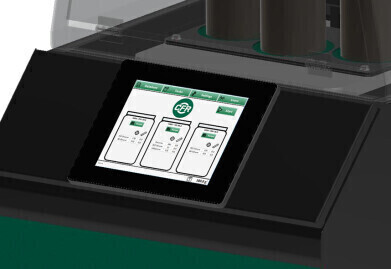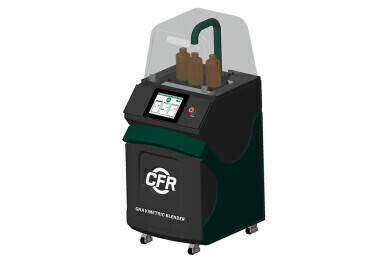Analytical Instrumentation
Blending reference fuels gravimetrically to ensure precise testing for CFR Engines
Dec 06 2023
Researchers and engineers use gravimetric blending to create custom fuel blends tailored to their specific testing requirements, such as octane rating, cetane number, or other performance parameters. This process allows them to mimic real-world fuel conditions, investigate knock resistance, emissions, and efficiency, and optimize engine designs accordingly.
The precise blending of primary, secondary, and standard fuels per ASTM D2699, D2700, and D613 is essential for the calibration and standardisation of the CFR engines used for the determination of the research octane number, motor octane number, and cetane number. To support reference fuel blending accuracy, CFR has developed a system for blending reference fuels gravimetrically. Blending fuels using a gravimetric blender for CFR (Cooperative Fuel Research) engines is a precise and essential process in engine research and development. This technique involves carefully mixing various components of fuel to achieve specific properties and characteristics needed for testing and optimizing engine performance.
The gravimetric blender operates by precisely measuring and combining different fuel components based on their weight, ensuring accurate and repeatable fuel compositions. This precision is crucial for CFR engine testing, where even minor variations in fuel formulation can significantly impact results.
The CFR engine, is a research tool designed to assess the performance and combustion characteristics of fuels used in internal combustion engines. These tests are especially important in the automotive and aviation industries, where engine efficiency, emissions control, and fuel development play significant roles.
The CFR engine operates under controlled conditions, such as constant compression ratio and intake temperature, to replicate combustion events accurately. To ensure reliable results, it's crucial to prepare test fuels with precision, mimicking real-world fuel properties. This is where the gravimetric blending of reference fuels comes into play.
Gravimetric blending is a precise and controlled process used in various industries, including chemical manufacturing, and fuel production. It involves the accurate measurement and combination of different substances based on their weight. This method ensures the creation of precise mixtures with known compositions, making it essential for applications where consistency and accuracy are paramount.
In gravimetric blending, components are carefully weighed and mixed according to specified ratios, resulting in a homogeneous blend. This process is valuable in fields such as pharmaceuticals, where medication formulations require exact proportions of active ingredients, or in materials manufacturing, where precise mixtures are needed for quality control.
Additionally, gravimetric blending plays a crucial role in the fuel industry, allowing for the precise formulation of custom fuel blends with specific properties for research, testing, and production purposes. This approach ensures that fuel properties, such as octane rating or cetane number, meet the desired standards, which is essential for optimizing engine performance.
Overall, gravimetric blending is a vital technique that enables industries to maintain quality, consistency, and accuracy in the creation of mixtures, contributing to improved product quality and performance across a range of applications.
The first step of gravimetric blending involves choosing the required reference components that will be blended to create the desired fuel. These components often include n-heptane and iso-octane, which serve as the basis for creating reference fuels with different octane values. The CFR GBS offers six (6) 10-litre fuel tanks for the reference components. These tanks can be replenished manually through fill nozzles or automatically when connected to fuel storage drums.
The next step is to determine the ratio of the blend. The target octane rating of the reference fuel dictates the proportions of n-heptane and iso-octane in the blend. Higher concentrations of iso-octane result in higher octane numbers, while higher n-heptane concentrations yield lower octane numbers. CFR GBS draws information from an on-board database of blend recipes and two-way communication with XCP® TECHNOLOGY.
Accurate weighing and mixing of each reference component is crucial. The components are carefully weighed and mixed in a controlled environment to ensure a uniform blend. Precision balances are used to measure the mass of each component down to the microgram level.
Once the blend is prepared, the final octane number is presented to the operator and the XCP system. If the properties of the blend are not within the desired range, adjustments can be made by altering the component ratios and repeating the weighing and mixing steps.
Gravimetric blending offers several advantages when preparing reference fuels for CFR engine tests. The method accounts for density differences between components, ensuring accurate ratios in the final blend. By precisely controlling component masses, researchers can replicate test conditions and compare results across different tests or laboratories.
Gravimetric blending provides a means of quality control, as deviations from expected results can indicate issues in the blending process or the quality of reference components. Accurate reference fuels enable better simulation of real-world engine conditions, aiding in the development of cleaner and more efficient combustion strategies. Each blend result is recorded in a database for future retrieval and record keeping. The data can be transferred to the XCP system to minimise human error. CFR’s integrated solution between the XCP and GBS offers a strategic advantage by streamlining the blending process, improving data accuracy, and enhancing overall efficiency.
Gravimetric blending is an indispensable technique for creating reference fuels in CFR engine tests. By combining pure components in carefully calculated ratios based on mass, researchers can achieve precise control over fuel properties. This accuracy ensures that the results obtained from CFR engine tests are reliable, consistent, and applicable to the development of advanced internal combustion engines and fuels. As technology continues to evolve, gravimetric blending remains a cornerstone of fuel research and engine development. The CFR Gravimetric Blending System (GBS), designed and manufactured in the USA, is the ideal solution for creating accurate and reliable reference fuels.
Digital Edition
PIN 25.3 June/July
June 2024
Analytical Instrumentation - Recent Advances In Various Bench Scale Accelerated Oxidative Testing Methods For Fuels - Petrochemical Industry: Anton Paar Solutions Streamline Processes, Reduce H...
View all digital editions
Events
Jul 30 2024 Jakarta, Indonesia
Jul 30 2024 Jakarta, Indonesia
China Energy Summit & Exhibition
Jul 31 2024 Beijing, China
Jul 31 2024 Chengdu, China
Aug 05 2024 Moon Township, PA, USA



















